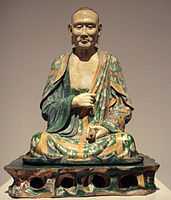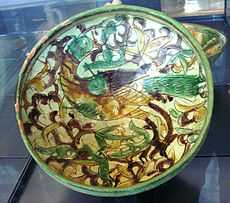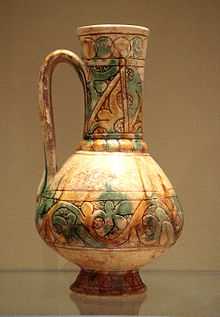Sancai

Sancai (Chinese: 三彩; pinyin: sāncǎi; literally: "three colours") is a type of decoration on Chinese pottery using three intermingled colors for decoration, particularly associated with the Tang Dynasty.[1] Therefore, it is most commonly referred to as Tang Sancai (Chinese: 唐三彩) in Chinese.
Technique

The body of sancai ceramics was made of white clay, coated with a layer of glaze, and fired at a temperature of 800 degrees Celsius. Sancai is a type of lead-glazed earthenware: lead oxide was the principal flux in the glaze, often mixed with quartz in the proportion of 3:1.[2] The polychrome effect was obtained by using as coloring agents copper (which turns green), iron (which turns brownish yellow), and less often manganese and cobalt (which turns blue).[2]
Sancai follows the development of green-glazed pottery dating back to the Han period (25-220 AD).[2]
Predecessors to the sancai style can also be seen in some Northern Qi (550-577) ceramic works. Northern Qi tombs have revealed some beautiful artifacts, such as porcellaneous ware with splashed green designs, previously thought to have been developed under the Tang dynasty.[3] Such a jar has been found in a Northern Qi tomb, which was closed in 576 AD, and is considered as a precursor of the Tang sancai style of ceramics.[4]
Development

The sancai technique dates back to the Tang Dynasty. However, the colors of the glazes used to decorate the wares of the Tang Dynasty generally were not limited to three in number. In the West, Tang sancai wares were sometimes referred to as egg-and-spinach by dealers, for their use of green, yellow, and white (though the latter of the two colors might be more properly described as amber and off-white or cream).
Sancai wares were northern wares made using white and buff-firing secondary kaolins and fire clays.[5] At kiln sites located at Tongchuan, Neiqui county in Hebei and Gongxian in Henan,[5] the clays used for burial wares were similar to those used by Tang potters. The burial wares were fired at a lower temperature than contemporaneous whitewares. Burial wares, such as the well-known representations of camels and horses, were cast in sections, in molds with the parts luted together using clay slip. In some cases, a degree of individuality was imparted to the assembled figurines by hand-carving.
-
Earthenware tomb figurine with sancai glaze, 7th-8th century, Tang Dynasty
-

Foreigner on a camel, in sancai style, Tang Dynasty.
-

Tang Dynasty sancai horse at the Shanghai Museum
-
A Tang sancai footed jar
-

Liao dynasty sancai luohan, circa 1000.
-
Sancai plate, Liao Dynasty, 10-12th century.
-

A Tang sancai vase, 8th-9th century
-

A Tang sancai figurine of civil official
-

A Tang sancai figurine of civil official
-

A Tang sancai statue of tome guardian beast
-

A Tang sancai statue of heavenly guardian
Influences
Sancai travelled along the Silk Road, to be later extensively used in Syrian, Cypriot, and then Italian pottery from the 13th to the middle of the 15th century. Sancai also became a popular style in Japanese and other East Asian ceramic arts.
-

Syrian three-color ceramic, 13th century.
-

Syrian three-color ceramic, 13th century.
-

Three-color glazed ceramics, Cyprus, 14th century.
-

Italian three-color Vase, Mid-15th century.
-

Italian three-color Bowl, Mid-15th century.
References
| Wikimedia Commons has media related to Sancai. |
- ↑ "Chinese Porcelain Glossary: Sancai". Gotheborg.com. Retrieved 26 April 2015.
- ↑ 2.0 2.1 2.2 Shanghai Museum permanent exhibit.
- ↑ The arts of China by Michael Sullivan p.19ff
- ↑ Chinese glazes: their origins, chemistry, and recreation by Nigel Wood p.200
- ↑ 5.0 5.1 Wood, Nigel (1999). Chinese Glazes. A.C. Black, London. ISBN 0-7136-3837-0.
External links
- A Handbook of Chinese Ceramics from The Metropolitan Museum of Art




